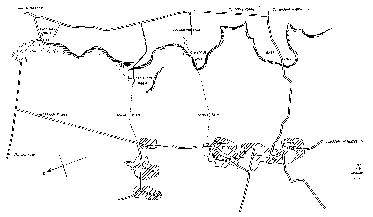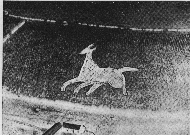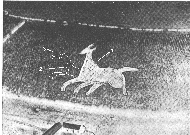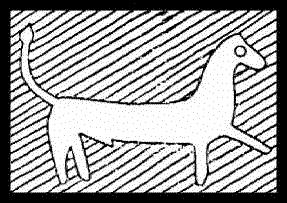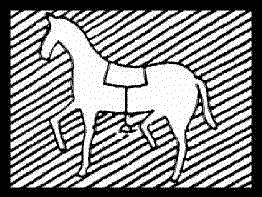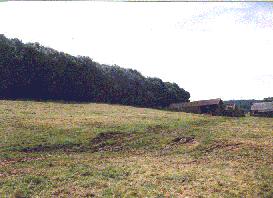The Red Horse of Tysoe
Many Thanks to Kenneth Carrdus who re discovered the Red Horse and Graham Miller who helped him in his research which he continues to this day. Allowing me to share their research and mine with you.
History
The origin of the horse is not known but some indication of it origin has been speculated about. The horse was cut on the orders of the Earl of Warwick as a monument to his horse which he killed at the Battle of Towston, Yorkshire in 1461. Legend has it that the Earl of Warwick was losing the battle and to prove to his men he would not leave he killed his horse, and fought shoulder to shoulder with his men, this was the turning point of the battle and he won. He had the horse cut in memory of this and set up a fund for the annual repair on the Palm Sunday (Anniversary of the Battle.)
Another theory has it that the Angles cut it and the smaller horse II when they colonised the stour valley in AD 600, it was used as a offering to fecundicity and fruitfulness.
There have been 5 horses cut into Edgehill scarp at two different sites, the hangings and spring hill. Some details are known about all these horses but the accuracy of these details cannot be evaluated. Indications are that the horses were crudely cut by stripping the turf off to reveal the red soil underneath and not the rock as the soil is quite thick on the escarpment. The horses would have to be well maintained and this may be the reason for their loss.
Kenneth Carrdus and Graham Miller
Red Horse of Tysoe I.
National Grid Ref SP 354 449
Possible Approximate Dates - pre1607 - 1700
The earliest and largest of all the horses 285' by 195' found in 1964 by ground surveys and aerial photographs. It was confirmed by the discovery of a map a short time later. The horse was first referred to in 1607, but could have been cut as early as 1461. Theory has it that it did not survive much later than 1656.
The photograph from September 1964 taken by Graham Miller of The Hangings clearly shows the outline of head, neck, back and tail of a large horse. (in frame)
Kenneth Carrdus and Graham Miller
The aerial photograph evidence was backed up by excavation and a resistivity survey the outline of this horse has been confirmed with this evidence.
Kenneth Carrdus and Graham Miller
This horse was discovered by Kenneth Carrus and Graham Miller, Kenneth Carrus started research in 1961 with Alan Forster who had to leave the area in 1962 and Graham Miller stepped in to help at this point. Two hills were candidates for investigation. The first a recently planted area between the hangings and Spring Hill yielded no evidence, however another researcher called Wildman thought otherwise .Details of his thought's can be found here
The second hill called Old Lodge Hill where Prof Ashby's map of the enclosure award had shown a horse, no evidence of a horse was found. Some photographs were taken using some special filters of the hillside in 1964, which was very dry and showed lots of vegetation marks, one of these photo's showed the Red Horse on the Hangings. This photo is shown above, a small part of the horse was excavated and a resistivity survey of part of the horse was carried out, both backed up the photograph.
Red Horse of Tysoe II and III.
National Grid Ref SP 354 449
Horse II
Possible Approximate Dates - pre1607 - 1700
The second horse is smaller than the first and partially covers it, although the second horse is slightly to the bottom left of the first. The outlines of both these horses were also discovered at the same time as the first horse but no excavations or resistivity surveys were carried out.
2 is the 2nd horse and 3 is the 3rd horse both outlined in white
Kenneth Carrdus and Graham Miller
Horse III
Possible Approximate Dates - Pre 1727 - 1800
All subsequent references were to a small horse presumably the third and smallest of the three horses which was 55' long and faces right. It is above and to the left of the first two horses. The third horse appears to be the one described by Rev Wise in 1742, who described it as inferior to the Uffington horse and not easily discernable from a distance. Maps of 1727 and 1798 confirm the position of a horse on this site probably this horse and the direction it faces - south.
Gough accurately measured a horse 1 mile from Sunrising Inn in 1772, it is suggested that is is the 3rd horse and not one of the first two due to is small size, and it was to early to be the fourth horse. The size was 34' from croup to chest, 14' from the shoulders to the ears, 7.5' from the ear to the nose, 10' from the underjaw to the bottom of the chest, 16' from shoulder to ground, 19.25' belly length, sheath 8', lail length 18', saddle 11' eye diameter 1' 2", feet 1' wide. The legs were as follows, off fore leg 12', near one 9', hind legs 10'. This horse was ploughed up in 1800.
The Aylesford print of 1798 shows a very stylised horse facing North and not south as does an old sketch of the horse, while Goughs horse faced south as does the map of 1727. However horse III faced South so there is some confusion. All the measurements are approx. correct so they are all talking about the same creature. The only explanation is that Aylesford changed the direction the horse faced, after all he did stylise the figure. (NB It is easier to draw a horse facing left if you are right handed, and easier to draw facing right if you are left handed.)
On a recent visit to the site the buildings are still present, but the area of the field where the horses were cut was semi covered with woods and gradually becoming encroached. The soil was very red and would have been an impressive site, had the slope been a bit steeper.
Red Horse of Tysoe IV and V.
National Grid Ref SP 3597 4569 and SP ??The two later horses were cut at Spring Hill after the other horses were lost. There is still some confusion as to their dimensions and when they were cut.
Horse IV
Possible Approximate Dates - 1800 - 1910
The first was cut in 1800, said to be cut by the Landlord of the pub Sunrising Inn. After the third horse was ploughed up. It was quite a small horse though, some articles say that sizes vary from 17-30' long. 17' seems to be the most quoted length. It resembled a pantomime horse with human feet.
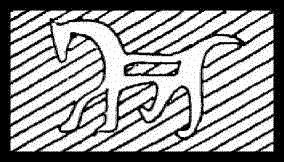
The horse was lost in 1910 when it was deliberately destroyed.
The position of both of these horses have been afforested and can not be recut, lost seemingly forever.
This 1905 map confirms the position of the 4th horse
Horse V
Possible Approximate Dates - unk - approx 1914
Recollections of a second horse at the site have been made by elderly local residents. A horse 10 yards long was mentioned by Turner in 1892. This could be the fifth horse, as it is too big to be the fourth.
The horse was cut on Spring Hill a little south of the 4th horse, very little is know about this horse it was said to have been seen in 1914, but the horse did not survive beyond the first world war.
Also Check out the useful information provided by Steve Hamilton (mirrored here.)
Steve Hamilton's Red Horse page
There is also more information provided by ?? (mirrored here.)
